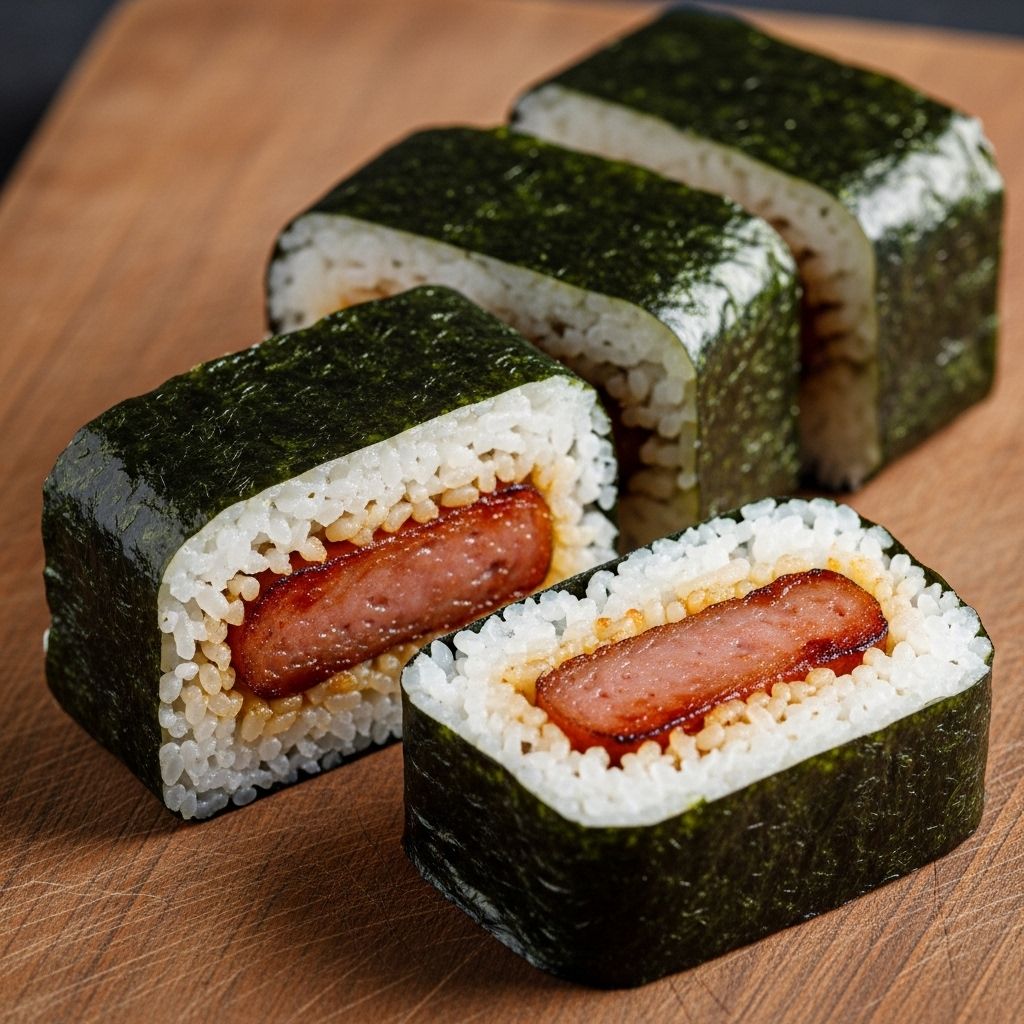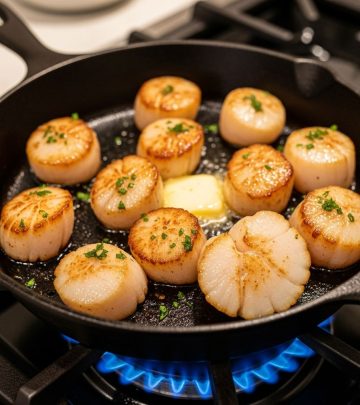Spam Musubi: Hawaiian Comfort, Japanese Inspiration
Discover the beloved Spam Musubi—Hawaii’s portable snack that unites Japanese technique with local flavor and comfort.

Spam Musubi is one of Hawaii’s most beloved snacks, blending sweet-savory fried Spam, sticky sushi rice, and crisp nori into an irresistibly portable treat. With roots in Japanese onigiri and deep ties to local Hawaiian culture, Spam Musubi is easy to make at home and endlessly customizable. Here you’ll find a step-by-step guide, foolproof tips, ideas for variations, and answers to all your musubi questions.
What is Spam Musubi?
At its core, Spam Musubi is a simple assembly of three ingredients: a slice of pan-fried Spam, seasoned sushi rice, and a strip of nori (seaweed) to bind them together in a neat rectangular package. It’s a familiar sight at Hawaiian lunch counters, convenience stores, and family gatherings.
- Filling: Pan-fried, sometimes teriyaki-glazed Spam.
- Rice: Warm, sticky, seasoned short-grain rice, shaped into a rectangle.
- Wrapper: A band or full wrap of nori for flavor and portability.
The snack reflects Hawaii’s multicultural roots, borrowing technique from Japanese onigiri and adapting it with an accessible, shelf-stable ingredient beloved in the islands.
History and Origin
Spam Musubi’s story is one of adaptation and invention. Spam, introduced to Hawaii during World War II, quickly became a staple. Japanese immigrants in Hawaii recognized similarities between Spam and familiar Japanese fish cakes, and blended it with their tradition of packing seasoned rice into snacks and lunches, resulting in the first Spam Musubi. Its popularity soared, and today it is embedded in local culture, appearing in everything from school lunches to potlucks and picnic baskets. The dish embodies a unique intersection of Japanese method and Hawaiian ingenuity, where practicality and resourcefulness created an iconic snack.
Ingredients for Classic Spam Musubi
- Spam: 1 can (12 ounces), preferably low sodium
- Sushi Rice: 2 cups uncooked Japanese short-grain rice, or 3 cups cooked
- Rice Vinegar: 2 teaspoons
- White Sugar: 1/2 teaspoon
- Salt: 1/2 teaspoon
- Nori: 1 full sheet, cut into strips
- Vegetable Oil: For frying
Optional sauce (for teriyaki-glazed Spam):
- 2 tablespoons regular soy sauce
- 2 tablespoons mirin (or substitute with additional rice vinegar and a pinch of sugar)
- 2 tablespoons sake (or a splash of water, if unavailable)
More adventurous versions might include furikake (seasoned seaweed sprinkles), spicy mayonnaise, or pickled ginger.
Essential Tools and Equipment
- Musubi Mold: A rectangular mold shaped like a Spam can (you can use the cleaned Spam can itself with plastic wrap as a liner as a budget alternative).
- Sharp knife: For cutting Spam and seaweed precisely.
- Plastic wrap: Helpful for unmolding and forming rice without sticking.
- Nonstick skillet: To achieve caramelized, even-browned Spam slices.
Step-by-Step Guide: How to Make Spam Musubi
Step 1: Prepare Sushi Rice
- Cook 2 cups Japanese short-grain rice according to package instructions. Fluffy, sticky rice works best for musubi.
- Once hot and cooked, season the rice in a bowl with 2 teaspoons rice vinegar, 1/2 teaspoon sugar, and 1/2 teaspoon salt. Gently fold using a rice paddle or spatula to avoid mashing grains. Cover and let cool to room temperature while you prepare other components.
Step 2: Slice and Fry the Spam
- Take a 12-ounce can of Spam out of the mold, and cut lengthwise into 8 even slices (each roughly a half-inch thick).
- Heat a nonstick skillet over medium heat and add a teaspoon of oil. Fry Spam in a single layer, undisturbed, for 1½ to 2 minutes per side. The goal is a golden-brown crust.
Step 3: (Optional) Glaze with Teriyaki Sauce
- Whisk together soy sauce, mirin, and sake (or your substitutions).
- Pour over the Spam slices in the skillet; let simmer for about 1 minute per side until the sauce reduces and clings as a shiny glaze. Remove caramelized Spam to a plate lined with parchment, and avoid overcooking in the residual heat (the glaze may burn).
Step 4: Mold the Rice
- Line your musubi mold, or clean Spam can, with a large sheet of plastic wrap—this makes removing rice much easier.
- Divide cooled seasoned rice into the same number of portions as you have Spam slices. Wet your rice paddle or fingers to prevent sticking, then scoop one portion into the lined mold.
- Spread the rice level and pack gently but firmly. Press using the mold or plastic to compact into a uniform block.
- Carefully lift the block from the mold and set aside on a flat cutting board. Repeat until all the rice is used.
Step 5: Assemble the Musubi
- Cut the nori sheet horizontally into even strips about 1 to 1½ inches wide. One full sheet typically yields 5 to 8 strips, matching your Spam slices.
- Set a strip of nori shiny-side down on a board. Place a block of rice in the center, top with a slice of Spam, then wrap the seaweed up and around both to seal. Dampen the end of the nori slightly to help it stick.
Step 6: Serve and Enjoy
- Spam Musubi can be served warm, at room temperature, or even wrapped for a hearty snack on the go.
- For parties or lunchboxes, wrap each musubi tightly in plastic wrap to keep the rice moist.
Pro Tips for the Best Spam Musubi
- Rice Texture: Use sushi or short-grain rice for the stickiest, most cohesive blocks.
- Don’t overpack: Compress the rice just enough so it holds its shape but isn’t dense.
- Avoid burning glazing Spam: Glazed Spam can scorch quickly; remove promptly from the skillet.
- Plastic wrap: Makes unmolding, compacting, and storage much easier (and less sticky!).
- Nori freshness: Use freshly opened nori for maximum crunch and flexibility. Stale nori will crack or turn chewy.
- Spice it up: Real Hawaiian musubi is often sprinkled with furikake seasoning or paired with spicy sauce.
Variations and Creative Twists
- Egg Musubi: Add a thin omelet under the Spam slice for breakfast flair.
- Avocado or Cucumber: Layer underneath the Spam for a fresh crunch.
- Kimchi: Add chopped, drained kimchi for a spicy, tangy bite.
- Furikake: Sprinkle seasoned seaweed and sesame mix between the rice and Spam for umami.
- Sriracha Mayo: Drizzle over the Spam before wrapping for heat and richness.
- Mini or Jumbo Musubi: Adjust the size to fit your mold or the occasion (cocktail party minis, meal-sized slabs).
Spam Musubi Serving Suggestions
- Pair with kimchi, pickled vegetables, or a crunchy slaw for balance.
- Pack in a bento box with fruit and salad for a complete lunch.
- Bring to picnics, road trips, or potlucks—Spam Musubi keeps and travels well.
- Serve warm, at room temperature, or gently reheat (wrapped) in a microwave for a quick snack.
Making Spam Musubi Without a Mold
If you don’t own a musubi mold, no problem. The cleaned, empty Spam can is the traditional DIY tool. Line the inside with plastic wrap, and use the can itself as your pressing mold. Lacking both, simply shape the rice by hand (dampen your hands, scoop, and shape into compact rectangles).}
Frequently Asked Questions (FAQs)
Q: What type of Spam tastes best for musubi?
A: The classic 12-ounce can works well, but the low-sodium or less-fat varieties are popular for a lighter touch. Some fans use flavored Spam, but the original is iconic. Just avoid versions with intense added flavors for a more traditional taste.
Q: Can musubi be made ahead?
A: Yes. For best results, wrap tightly in plastic and store in the refrigerator for up to 2 days. Gently warm before eating for optimal texture. Nori may lose its crunch, so consider leaving it unwrapped until serving if you prefer crisp seaweed.
Q: How do I keep rice from sticking to my hands and tools?
A: Use slightly wet (but not dripping) hands or dip your rice paddle in a little water before shaping. Optionally, wear food-safe gloves lightly dampened with water.
Q: Is Spam Musubi gluten-free?
A: Traditional Spam is gluten-free, but check labels for flavored varieties and use gluten-free soy sauce for the glaze to ensure the entire snack is safe.
Q: What rice substitutions can be made?
A: Authentic musubi relies on sticky, short-grain rice for best binding. Medium grain or sushi rice are also effective; avoid long-grain types as they’ll fall apart during assembly.
Nutritional Information
| Component | Approximate per musubi |
|---|---|
| Calories | 230-280 |
| Protein | 7-9g |
| Carbs | 35g |
| Fat | 7-10g |
Spam Musubi vs. Japanese Onigiri
| Aspect | Spam Musubi | Onigiri |
|---|---|---|
| Core Protein | Spam (fried/teriyaki) | Fish, pickled plum, or other fillings |
| Rice Shape | Rectangular block | Ball or triangle |
| Nori Wrap | Usually a strip, sometimes full wrap | Varies, sometimes partial or no wrap |
| Origin | Hawaii/Local fusion | Japan |
Final Thoughts: Why You Should Try Spam Musubi
From quick snacks to lunchbox staples, Spam Musubi offers a unique combination of savory, satisfying flavors with nostalgic and cultural undertones. Its assembly is fun and practical, making it a perfect starting point for cooks of all skill levels to explore both Japanese and Hawaiian culinary traditions at home. Whether you love it plain, with a spicy twist, or stacked with fun add-ins, Spam Musubi will win over curious foodies and comfort-seekers alike.












